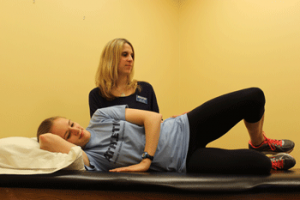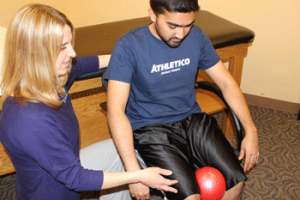
Let’s Talk About the Pelvic Floor
1 CommentYour doctor is talking to you about recent pain you’ve experienced and suggests it come from your pelvic floor. What is the pelvic floor? Do I have one? Why is it there? Should I be concerned about my pelvic floor pain? Let’s discuss this often unknown area, and give you a better idea of what is going on in your pelvic floor.
What is the Pelvic Floor
Your pelvic floor is a group of muscles located at the bottom of the pelvis. The purpose of the pelvic floor is three-fold.
- It supports the pelvic organs, which include the bladder, uterus and the intestines.
- It aids in maintaining continence, both urinary and fecal.
- It provides stability to the pelvis along with the gluteal and abdominal muscles. This supports your spine and pelvis during everyday activities such as walking, lifting and changing positions.
Both women and men have a pelvic floor as the muscular function is necessary for both genders.
 Often, the muscles in the pelvic floor region are neglected and don’t get exercised as regularly as other muscles in our bodies. Since pelvic floor muscles are at the center of the body, they can affect how we move and use our bodies. Weakness in these muscles can affect pelvic stability and, at times, contribute to lower back pain.
Often, the muscles in the pelvic floor region are neglected and don’t get exercised as regularly as other muscles in our bodies. Since pelvic floor muscles are at the center of the body, they can affect how we move and use our bodies. Weakness in these muscles can affect pelvic stability and, at times, contribute to lower back pain.
Other muscles in the gluteals, trunk or legs may compensate for the weakness in the pelvic floor leading to improper or overuse of other muscles, as well as muscular imbalance in the pelvic area. This can cause pain symptoms that can travel upward into the trunk or neck region, or downward to the hips or knees.
If pelvic floor muscles are weak or if there has been physical trauma, such as childbirth or surgery, they may not support the pelvic organs properly. This can lead to a collapse of the bladder, uterus, or rectum. Additionally, weak pelvic floor muscles can lead to difficulties with maintaining continence. It’s important to exercise these muscles regularly by performing Kegel exercises that improve and maintain your strength. Physical therapy treatment uses biofeedback to assist you in performing the Kegel exercises properly, which assists with improving your strength.
Do you have pain in your pelvic floor?
This could include pain with sitting, standing, walking, urinating or having a bowel movement.  There can also be pain during a pelvic exam, use of a tampon or with intercourse. These symptoms are indicative of a pelvic floor problem and you should talk to your physician about your pain. Physical therapy with a Women’s and Men’s Health specialist can assist with release of the tension, stretching and strengthening in the muscles to improve muscular balance in the area. You also will be provided with a home exercise program in conjunction with your treatment to improve your progress.
There can also be pain during a pelvic exam, use of a tampon or with intercourse. These symptoms are indicative of a pelvic floor problem and you should talk to your physician about your pain. Physical therapy with a Women’s and Men’s Health specialist can assist with release of the tension, stretching and strengthening in the muscles to improve muscular balance in the area. You also will be provided with a home exercise program in conjunction with your treatment to improve your progress.
Watch Pelvic Floor Exercise Videos Here.
If you have questions about your pelvic floor, please contact one of our knowledgeable Women’s and Men’s Health specialists today to answer your questions and begin your treatment.

1 Comment
Ivy Baker
This is some really good information about pelvic pain. I liked that you talked about how it would be a good idea to strengthen your muscles if you have a pelvic pain. After all, it would be a good idea to have a professional help you recover from if you do have pain.